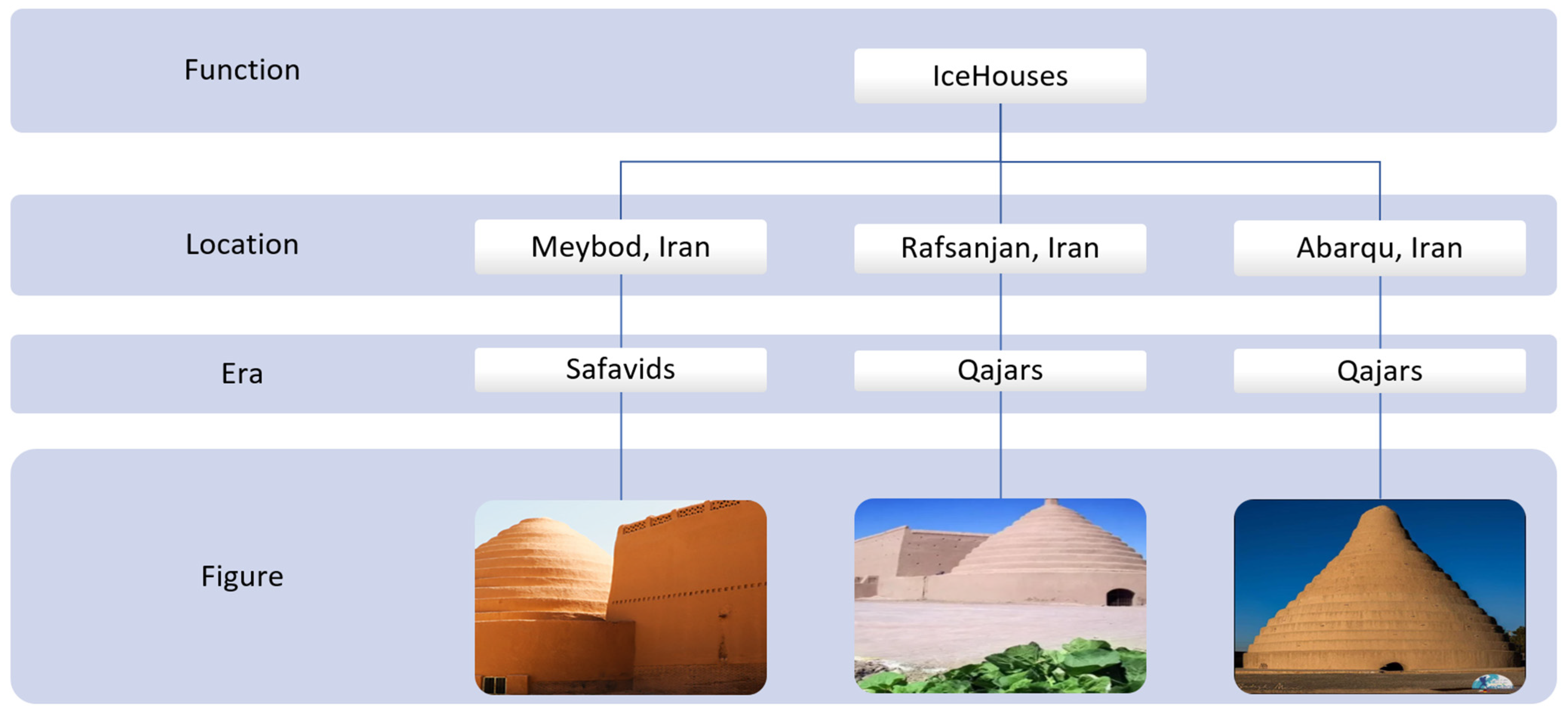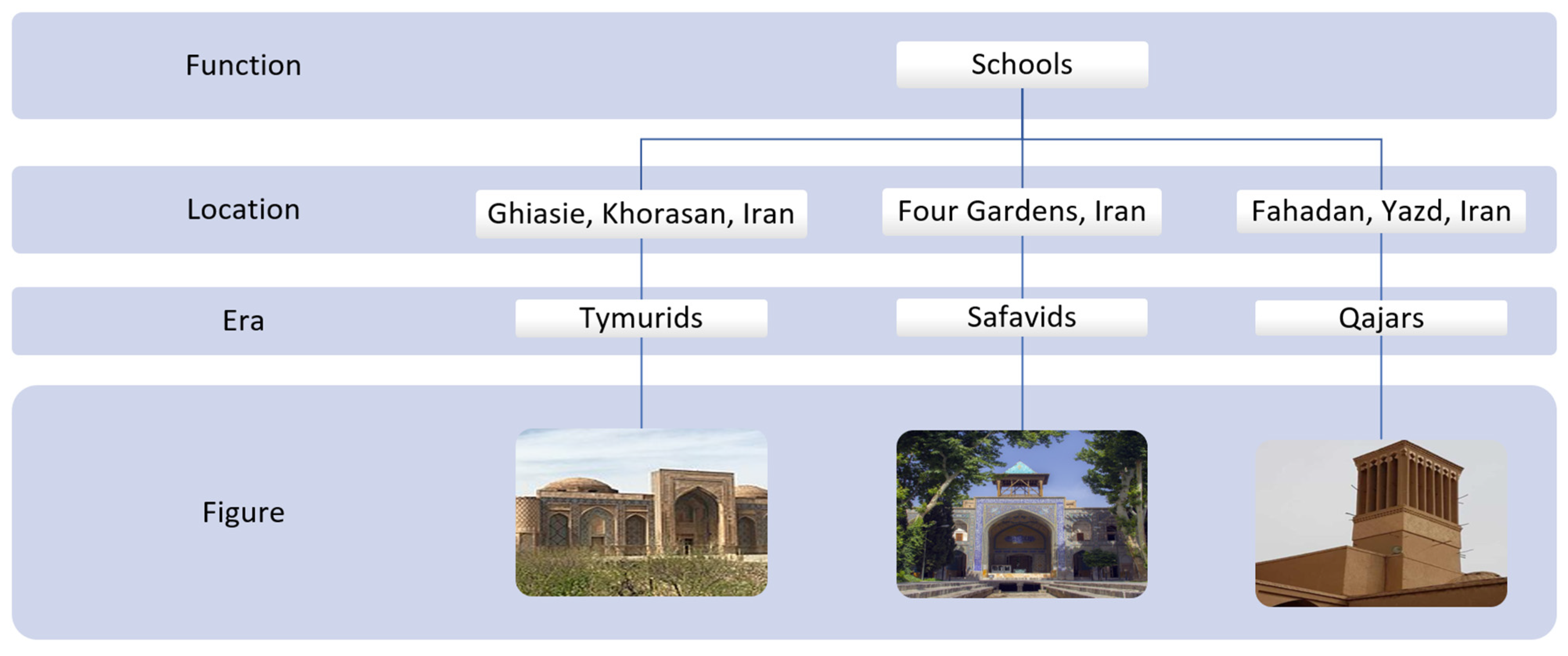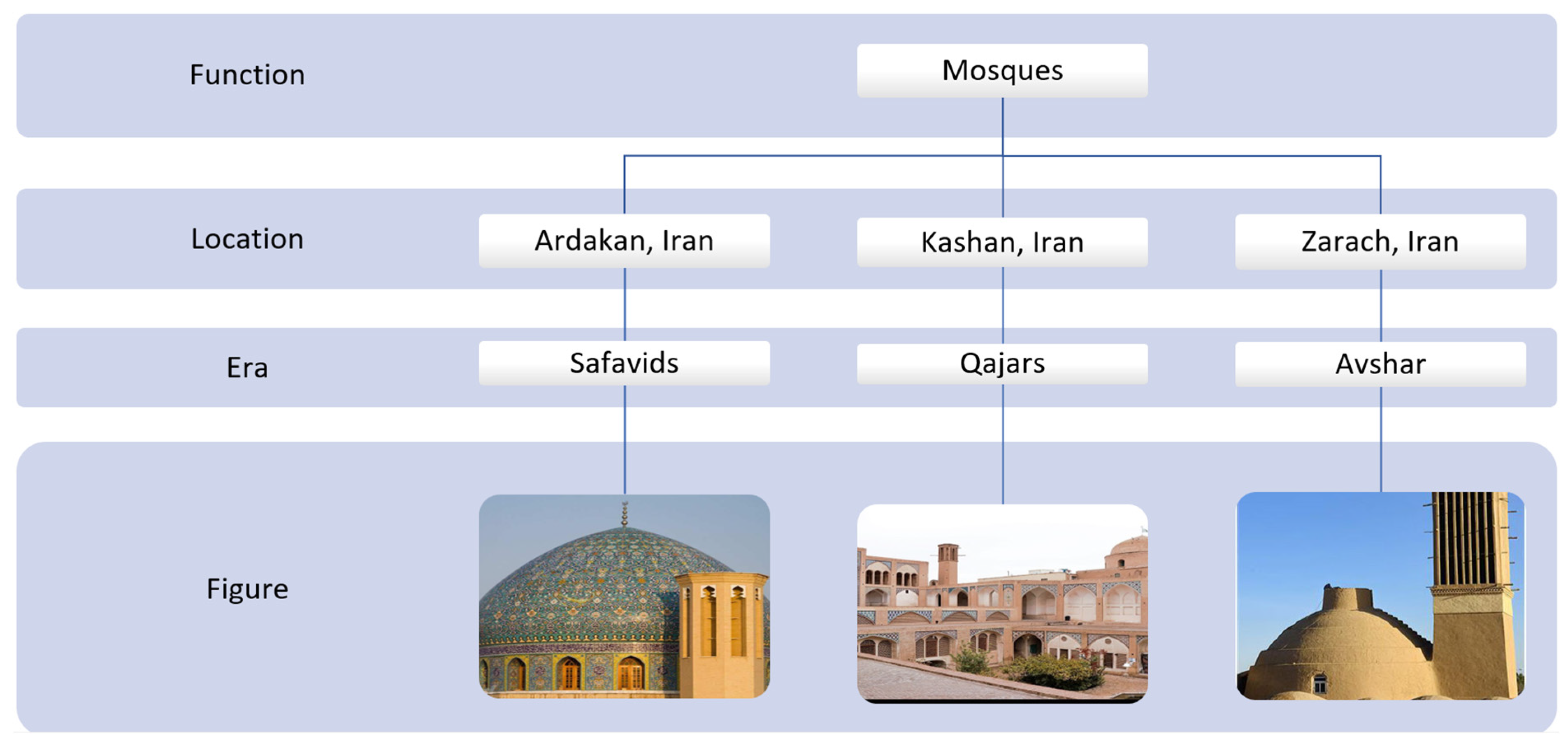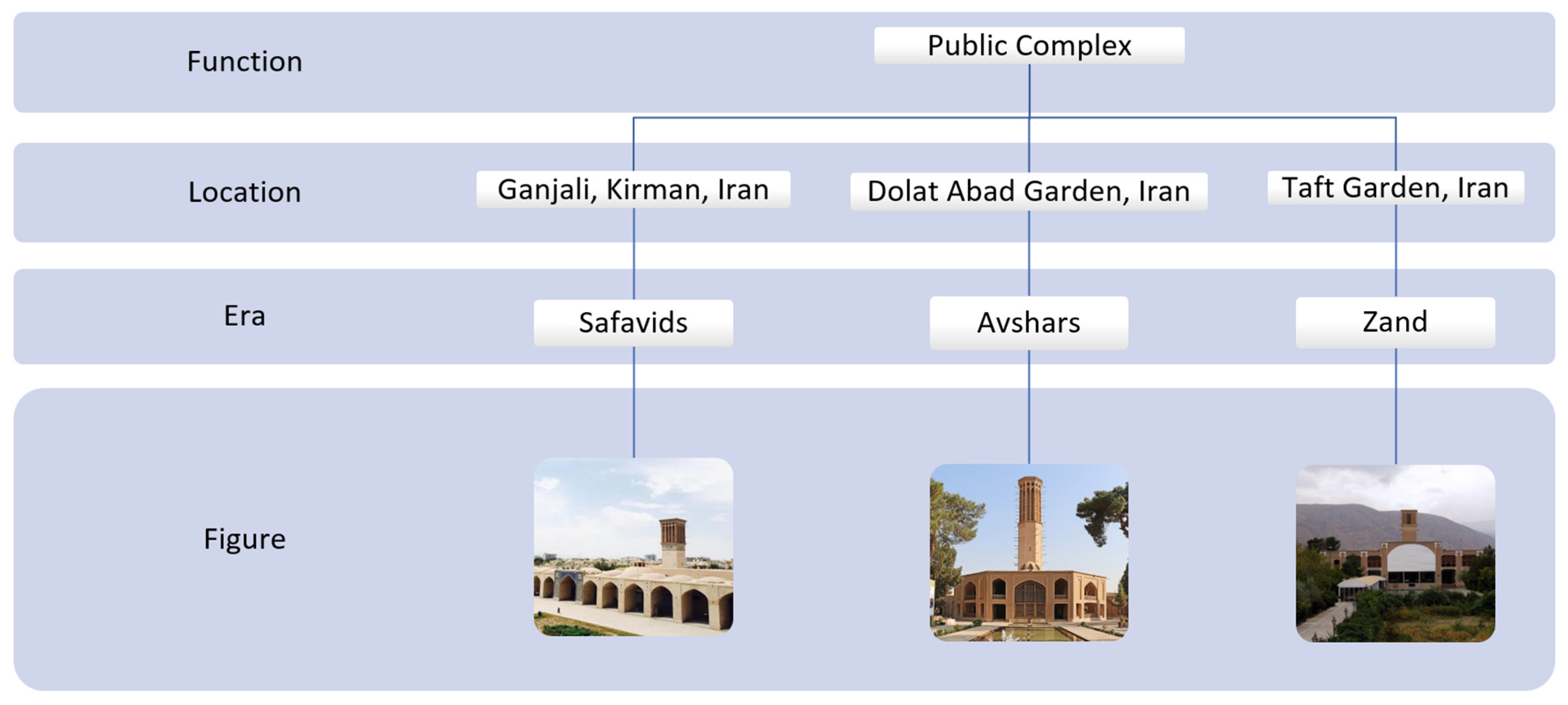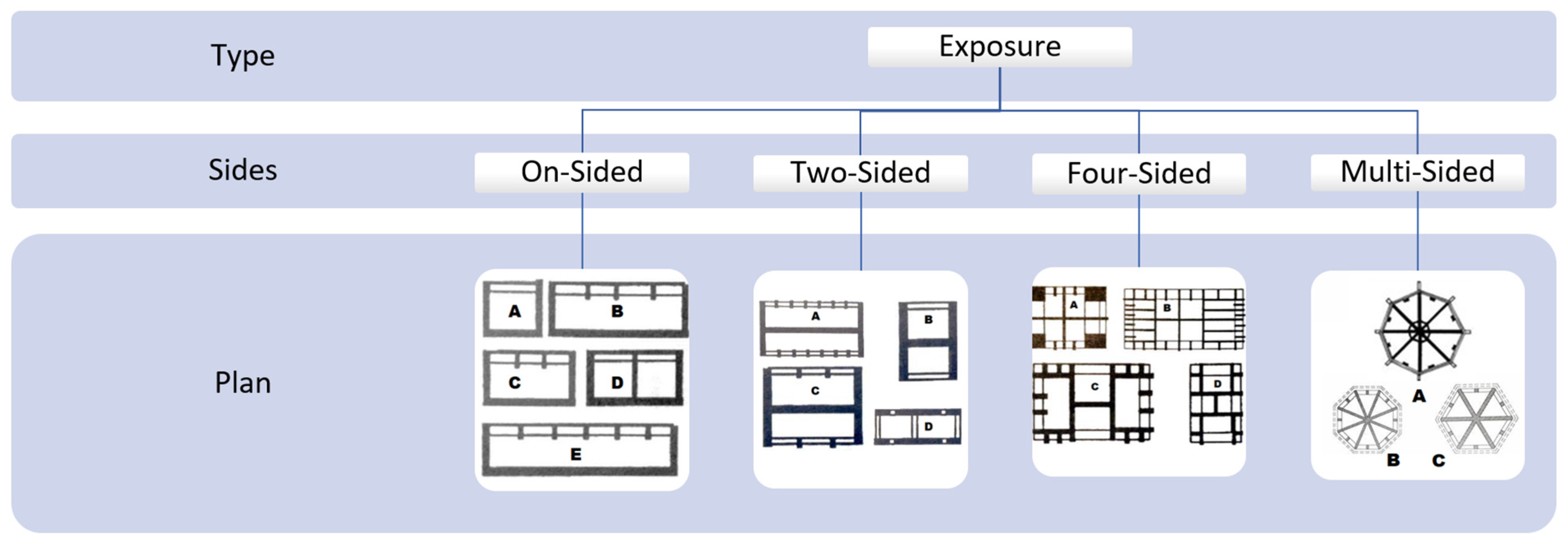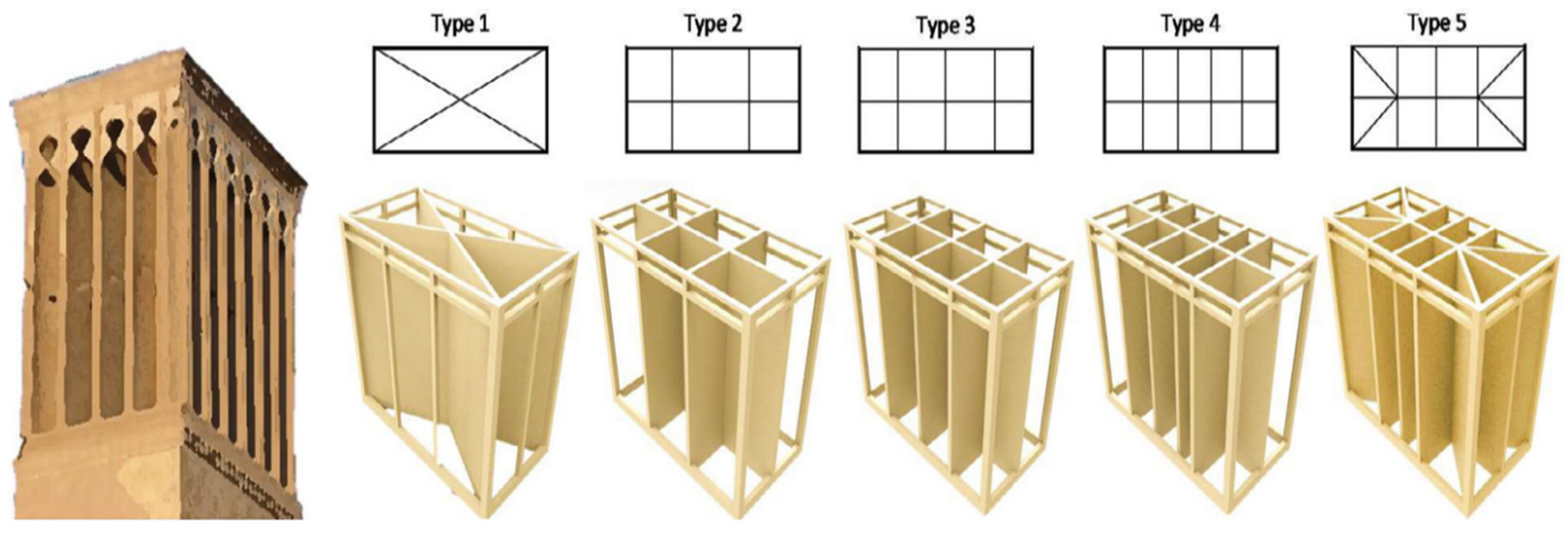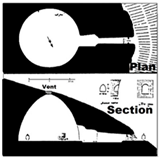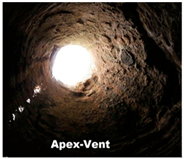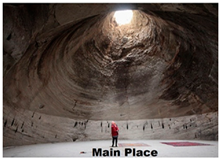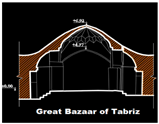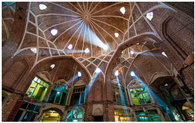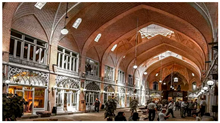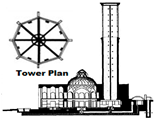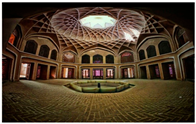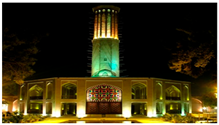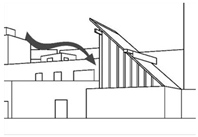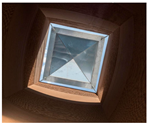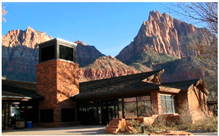1. Introduction
Wind power has long played a vital role in shaping human civilization, influencing both technological advancements and architectural innovations. Among its earliest applications, wind catchers’ ingenious structures designed to regulate indoor temperatures represent one of the most effective passive cooling systems developed in hot and arid climates [
1]. These structures have been widely used across Mesopotamia, ancient Egypt, and the Middle East, adapting to various environmental challenges over centuries [
2].
Architectural refinement during the Safavid and Qajar dynasties further enhanced the efficiency and aesthetic appeal of wind catchers, transforming them from functional elements into symbolic expressions of vernacular design [
3]. Studies highlight wind catchers as zero-energy ventilation systems, uniquely suited for hot, arid, and humid regions, owing to their ability to function as both wind scoops and heat sinks depending on design variations [
4].
Over time, technological transformations have led to significant optimizations in wind intake mechanisms, structural modifications to prevent dust and rain penetration, and improved opening dimensions for enhanced air circulation [
5,
6]. Modern architecture increasingly integrates wind catchers not merely as ventilation structures but as urban design components, emphasizing their dual role in aesthetics and environmental efficiency [
7,
8].
The primary objective of this study is to examine the historical evolution, functional diversity, and technological advancements of wind catchers while exploring their transition into modern sustainable architecture. With the growing demand for eco-friendly construction, understanding the fundamentals of passive cooling techniques can provide invaluable insights into low-energy urban planning strategies [
9,
10]. Furthermore, this research highlights how wind catchers, originally designed for climate adaptation, have evolved into conceptual art forms, merging cultural heritage and contemporary innovations [
11,
12].
To address these environmental challenges, this study investigates the revival and modernization of wind catcher systems, integrating them with contemporary architectural and energy-efficient technologies. By exploring hybrid configurations, smart controls, and solar-assisted mechanisms, this research aims to demonstrate how traditional passive cooling methods can evolve into scalable solutions for sustainable urban development. The entry point of this study lies in bridging heritage-based design principles with current demands for climate-adaptive and low-carbon architecture. The core innovation is the proposed integration of wind catchers with AI-based control strategies and solar energy systems, offering a unique framework for enhanced thermal comfort and energy efficiency in dense urban environments.
Finally, this paper aims to evaluate the feasibility of reinterpreting traditional wind catcher typologies in contemporary architecture and to analyze their potential for providing sustainable natural ventilation and cooling in modern urban contexts.
2. Literature Review
Previous experimental and computational studies on windcatcher performance vary in scope and methodology.
Table 1,
Table 2 and
Table 3 summarize the key findings grouped by analytical technique and architectural relevance, emphasizing their contribution to modern sustainable ventilation design. Studies included in
Table 1,
Table 2 and
Table 3 were selected based on their relevance to traditional and modern passive cooling strategies, with a focus on peer-reviewed literature and empirical cases across diverse climatic regions.
Table 1 highlights empirical findings from full-scale or real-world prototypes of windcatchers in different contexts (buildings, greenhouses, and courtyards). It shows the versatility of four-sided designs and the innovative use of pressure differentials or segmentation. These results establish a reliable foundation for validating your simulation framework and selecting design parameters.
Table 1.
Key experimental studies on wind catchers.
Table 1.
Key experimental studies on wind catchers.
| Strategy | Wind Catcher Type | Key Outcome | Refs. |
|---|
| Building Ventilation | Four-sided | Negative pressure effect enhances overall ventilation | [1] |
| Heat Recovery | One-sided | Internal segmentation boosts airflow velocity | [6] |
| Greenhouse | Multi-sided | Air velocity ranges from 0.3 to 1.8 m/s at plant height | [13] |
| Courtyard Vent. | Four-sided | Up to 60% air extraction from prevailing wind directions | [14] |
| Solar Fan | Four-sided | Achieves 20 Pa pressure ventilation under low wind speeds | [15] |
Table 2 summarizes insights from CFD-based simulations and analytical models. It offers precise quantifications and geometry-specific results, showing how computational optimization and smart control strategies can increase wind catcher efficiency. These references are crucial for modeling assumptions and boundary conditions in your numerical section.
Table 2.
Numerical and theoretical studies.
Table 2.
Numerical and theoretical studies.
| Strategy | Wind Catcher Type | Main Finding | Refs. |
|---|
| Solar Chimney | One-sided | Performance improved by the optimal aspect ratio | [16] |
| Hybrid System | Multi-sided | Optimized via CFD layering and geometric refinement | [3] |
| Wind catcher Wall | Two-sided | Efficiency drops with wall length increase (10–100 cm) | [17] |
| Intelligent Control | Multi-directional | Enhanced cooling via AI-equipped adjustable louvers | [18] |
Table 3 bridges the gap between theoretical concepts and real-world validation. Using combined or semi-empirical approaches, these studies provide actionable values like ACH and airflow percentages. They help ground your proposed design in practical benchmarks and offer comparative metrics for performance validation.
Table 3.
Semi-experimental and combined studies.
Table 3.
Semi-experimental and combined studies.
| Strategy | Wind Catcher Type | Finding | Refs. |
|---|
| Building Ventilation | Four-sided | 4.8 ACH achieved in full open configuration | [19] |
| Heat Recovery | Four-sided | Airflow reduction observed through the rotary heat exchanger | [20] |
| Natural Ventilation | Square-form | 47% ventilation efficiency gain with open windows | [21] |
Wind catchers have historically served as an essential passive cooling system, with roots tracing back to ancient Mesopotamian fire temples and Egyptian structures [
1,
7]. Some of the oldest evidence of wind-driven ventilation can be found in Mithra temples in Tabriz–Eastern Azerbaijan, dating back 12,000 years, showcasing early experimentation with passive airflow regulation [
2,
22].
During the Safavid and Qajar dynasties, wind catchers underwent architectural advancements, with designers refining multi-directional towers to harness seasonal wind patterns for continuous cooling efficiency [
3,
5]. Studies show that four-sided square wind catchers outperform one-sided designs, extracting air at 60% efficiency under optimal wind incident angles [
4,
14,
23]. Similarly, courtyard-integrated wind catchers improved indoor circulation rates, varying between 0 and 1.5 m/s based on outdoor wind speeds of 1–8 m/s [
6,
24]. Wind catchers later spread across North Africa, Persia, Pakistan, and Afghanistan, adapting to coastal, arid, and semi-humid climates. Egyptian Malqafs, Moroccan courtyard wind catchers, and Abbasid palace ventilation towers demonstrate regional modifications aimed at balancing humidity levels and improving airflow [
8,
25].
The integration of computational fluid dynamics (CFD) simulations has significantly enhanced wind catcher efficiency, allowing researchers to optimize height-to-width ratios, aperture dimensions, and shaft orientation [
26].
Wind catchers—when combined with solar chimneys, heat recovery networks, and automated airflow control—improve ventilation rates by up to 78%, reducing dependency on mechanical cooling systems [
12,
19]. Buildings featuring strategically positioned windows on leeward sides experience enhanced airflow circulation, driven by negative pressure differentials [
2,
27].
Studies reveal that solar-assisted wind catchers achieve ventilation rates exceeding 1700 m
3/h/h/person, improving energy efficiency by 60% compared to conventional HVAC systems [
8,
21]. Computational models demonstrate that adjustable sensor-controlled louvers further refine cooling effectiveness, paving the way for adaptive urban climate solutions [
16,
28].
Wind catchers traditionally relied on mudbrick, wood, and plaster, valued for their thermal mass and insulation properties [
29]. Studies highlight the impact of streamwise spacing in passive heat recovery wind catchers, showing that modifications to rotary heat recovery wheels can cause airflow blockage, but adequate ventilation is still maintained [
20]. However, modern architectural advancements introduce biodegradable coatings, high-performance recycled composites, and eco-friendly ventilation systems, improving structural durability and energy neutrality [
30].
Studies confirm that mudbrick wind catchers sustain indoor temperatures 30–40% lower than conventional concrete buildings, demonstrating superior energy retention [
24,
26]. Agricultural and greenhouse applications of wind catchers have shown optimized airflow dynamics at crop height (0.3–1.8 m/s), aligning with standard ventilation requirements [
13,
14,
31].
Successful modern implementations include solar chimney-wind catcher hybrids, which improve ventilation rates while simultaneously lowering energy consumption [
15]. Studies reveal that wing wall-integrated wind catchers provide an optimal balance of wind capture and heat dissipation in densely populated urban environments [
30]. Wind catchers continue to influence modern sustainable architecture, with successful implementations in urban planning and smart buildings. Studies on solar chimney–wind catcher hybrids show that ventilation performance improves proportionally with tower aspect ratio [
16], while models incorporating wing walls demonstrate a gradual reduction in airflow efficiency as wall length increases from 10 cm to 100 cm [
17]. Case studies, such as the Zion National Park Visitor Center (USA) and Council House 2 (Australia), highlight the application of natural ventilation principles to zero-energy cooling solutions. Furthermore, researchers have experimented with wind catcher integration in renewable systems, noting their effectiveness in varying architectural configurations [
23].
Wind catchers serve as both functional cooling mechanisms and artistic architectural icons. Research highlights their fusion of heritage preservation with contemporary advancements, reinforcing their role in eco-conscious urban designs [
13]. The conceptual reinterpretation of wind catchers in modern cities, particularly in Dubai and Doha, integrates solar-powered ventilation towers, demonstrating their dual significance in heritage and innovation [
20,
32].
3. Wind Catchers in Different Locations
Wind catchers—also known as Yel-Çəkən or Rüzgar-Yakalayıcı in Turkish, Badgers in Persian, and Malqafs in Egyptian architecture—are among the most significant passive cooling structures developed in hot and arid climates. Their evolution spans millennia, adapting to diverse environmental conditions and influencing architectural styles across the Middle East, North Africa, and Central Asia. These structures have played a critical role in temperature regulation, air purification, and energy conservation, demonstrating architectural ingenuity that remains relevant today.
Table 4 presents a chronological and cross-cultural survey of wind catcher technologies from 12,000 BCE to the present, spanning regions such as Egypt, Iran, Iraq, the Gulf, and the United States. It showcases architectural diagrams, interior views, and spatial layouts of various wind catcher systems, highlighting their evolving functions from passive cooling and natural ventilation in ancient mastabas and bazaars to hybrid approaches integrating shading and evaporative cooling in modern urban settings. The table reveals how apex-vent designs, sectional geometry, and internal spaces are adapted to meet both climatic and cultural needs. Notably, innovations like multi-directional airflow towers in Iran and polygonal wind catchers in the UAE illustrate the transition from vernacular designs to contemporary sustainable strategies. This visual compilation reinforces the argument that wind catcher architecture, though rooted in tradition, continues to influence present-day environmental design thinking.
The earliest evidence of wind catchers dates back over 12,000 years, originating in fire temples and sacred structures linked to Mithra worship in the Caucasus and Tabriz, East Azerbaijan State of Iran [
7,
33,
38]. These structures, often carved into rock formations or built with wind-permeable designs, allowed for the natural movement of air, a concept that later evolved into the sophisticated wind catchers seen in Persian cities such as Yazd, Isfahan, and Kashan.
Archaeological studies suggest that apex vents in temples such as Badamyar or Qadamgah Mithra Temple were precursors to modern wind catchers, facilitating air movement and smoke extraction in enclosed environments [
3,
7]. Traditional marketplaces, including the UNESCO-listed Tabriz Bazaar, incorporated arched roofs and domed ceilings, optimizing wind-driven ventilation to regulate indoor temperatures [
39] (
Table 4).
In the Persian States or central parts of Iran, wind catchers or “Badgir” were designed to harness prevailing winds, directing cool air into buildings while expelling warm air. Their effectiveness in passive cooling made them indispensable in arid and semi-arid climates, particularly in cities like Yazd, Isfahan, and Kashan. The Safavid and Qajar dynasties refined these designs, incorporating multi-directional openings to capture winds from various angles, ensuring continuous airflow regardless of seasonal changes.
Among the tallest and most iconic wind catchers in Iran, the Dolat-Abad wind catcher, constructed with a unique height and multi-directional structure, marks a shift from single-sided openings to more advanced cross-ventilation strategies. While its technical performance will be discussed in detail in
Section 4.1, herein, we emphasize its historical significance as an exemplar of Qajar-era architecture’s climatic adaptation.
Egyptian wind catchers, or Malqafs, were widely implemented in Pharaonic architecture, particularly in Luxor and Cairo [
2,
35]. Unlike Persian Badgers, Malqafs were triangular or rectangular, positioned atop buildings to funnel air downward, ensuring effective cooling in humid coastal regions [
36].
In Morocco and Tunisia, wind catchers were embedded into courtyard designs, complemented by shaded alleys and water features, which enhanced cooling efficiency [
4,
40]. The Abbasid palace of Ukhaidir in Iraq, built in the 8th century, demonstrates a four-sided wind catcher configuration, showcasing Iranian architectural influence on passive ventilation techniques [
8,
41].
Despite the rise of mechanical ventilation systems, wind catchers have persisted in contemporary architecture, particularly in sustainable design. Modern adaptations focus on improving wind intake, preventing dust and rain penetration, and optimizing shaft dimensions to enhance efficiency. Some designs incorporate sensor-controlled moving parts or solar-powered fans, blending traditional principles with modern technology.
Cities like Dubai and Doha have revived wind catcher designs in urban planning, using them to reduce reliance on air conditioning and promote eco-friendly cooling solutions. Additionally, architects have experimented with wind catchers in outdoor spaces, such as public squares and parks, to create naturally ventilated environments.
By tracing their historical evolution, it is evident that wind catchers remain a symbol of architectural ingenuity, seamlessly merging heritage with innovation. Their continued relevance underscores the importance of passive cooling techniques in addressing modern sustainability challenges.
Table 4 illustrates different forms of natural ventilation since the Stone Age. It shows how wind catchers are evolutionary integrated with different usages.
4. Systematic Classification of Wind Catchers
The functionality of wind catchers has been categorized into eight classes, consisting of water reservoirs, icehouses, residential, schools, mosques, bathhouses, bazaars, and public complexes (
Table 5). Functional categories were identified through a synthesis of archival research, field-based architectural surveys, and descriptive and comparative analyses of vernacular cooling structures across key cultural geographies.
Wind catchers have been integrated into various architectural structures to enhance natural ventilation and passive cooling, particularly in water reservoirs across different eras and regions of Iran. As depicted in
Figure 1, the water reservoir in Nain, constructed during the Safavid period, exemplifies early wind catcher applications, utilizing multi-directional airflow to prevent stagnation. Similarly, the Qajar-era reservoir in Yazd demonstrates advancements in wind catcher design, optimizing air circulation for thermal regulation and evaporation control. The third reservoir in Qazvin, also dating back to the Qajar era, highlights how regional adaptations influenced wind catcher functionality, ensuring effective heat dissipation and humidity balance. These examples showcase the evolution of wind catchers in water management systems, reinforcing their role in sustainable, climate-responsive architecture.
Ice houses, or Yakhchāls, have historically relied on natural ventilation to regulate internal temperatures, preserving ice throughout the year in arid climates. As shown in
Figure 2, the Maybod ice house, one of the oldest and most well-documented structures, demonstrates the effectiveness of wind catcher integration in channeling cool air while allowing heat to escape. The Rafsanjan ice house, similarly designed for passive cooling, utilizes thick adobe walls and strategic airflow pathways to enhance insulation and minimize heat transfer. The third example, from Abarqu, illustrates how regional adaptations influenced ventilation efficiency, incorporating appropriate airflow to optimize cooling performance. These historical structures showcase sustainable cooling techniques, emphasizing the role of wind catchers and thermal insulation in maintaining low temperatures without mechanical intervention.
Various historical houses across Iran showcase unique adaptations of wind catcher technology tailored to regional climatic conditions (
Figure 3). The House of Khan in Bushehr represents a coastal adaptation of wind catchers, where high humidity and warm air necessitate enhanced airflow for cooling. Its structure integrates tall wind towers, which capture sea breezes and circulate air throughout the residence, ensuring thermal comfort. The Tabatabai House in Kashan, located in an arid region, demonstrates multi-directional wind catchers that optimize air circulation while incorporating courtyard cooling techniques. The combination of central pools and wind catcher-assisted airflow significantly improves indoor temperature regulation. The Lari House in Yazd further exemplifies efficient passive cooling in desert climates. Its high wind catchers facilitate airflow across multiple floors, working alongside thick adobe walls that stabilize indoor temperatures by absorbing and gradually releasing heat throughout the day.
Wind catchers have played a crucial role in educational architecture, ensuring comfortable learning environments by facilitating natural ventilation and thermal regulation. As shown in
Figure 4, different schools across Iran have integrated wind catchers to optimize airflow and temperature control, creating passive cooling systems suited to regional climates. The Ghissie School in Khorasan is a prime example of a wind catcher application for cooling large educational spaces, where multiple wind towers work to enhance air circulation, ensuring stable indoor conditions for students. The Chahar-Bagh School, which is located in a hot and dry region, features tall wind catchers that maximize airflow efficiency. These structures channel fresh air into classrooms while expelling warm air, maintaining optimal learning conditions throughout the day. The Fahadan School in Yazd, a city renowned for its desert climate, incorporates multi-directional wind catchers that allow for controlled ventilation depending on wind patterns. Combined with thick adobe walls, this design enhances passive cooling, ensuring long-lasting thermal comfort within the building.
As illustrated in
Figure 5, different mosques in Iran demonstrate the strategic use of wind catchers in enhancing airflow and maintaining cool interior spaces. The Ardakan Mosque, located in a desert climate, integrates a wind catcher positioned directly above the mihrab (prayer niche), allowing fresh air to circulate through the mosque and cooling various sections of the building. This placement ensures effective passive ventilation, distributing airflow evenly throughout the prayer hall. The Agha-Bozorg Mosque in Kashan features a traditional multi-directional wind catcher, optimized for air movement across different zones of the mosque. Its large courtyard and subterranean cooling spaces work in conjunction with wind catchers, ensuring stable indoor temperatures even in peak heat conditions. The Zarach Mosque demonstrates regional adaptations in wind catcher placement, focusing on single-sided wind catchers that capture prevailing winds. In many historical mosques of Ardakan, wind catchers exhibit a northern orientation, regardless of their location on the north or south side of the building. This consistent design approach maximizes ventilation efficiency by harnessing dominant wind patterns. The Zirdeh Mosque in Ardakan is a notable example, where its asymmetrical single-sided wind catcher contributes to the distinctive architectural character while fulfilling essential cooling functions.
The Ganjali-Khan Complex, located in Kerman, exemplifies the use of wind catchers in urban planning and multifunctional spaces. Serving as a bazaar, bathhouse, mosque, and water reservoir, its wind catchers regulate indoor temperatures, ensuring comfortable conditions for visitors and merchants. These structures optimize air circulation across various functional areas, demonstrating their adaptability in public spaces (
Figure 6). The Dolat-Abad Garden in Yazd is an outstanding example of wind catcher technology applied to garden design, as introduced in the previous sections. The Taft Garden, another notable example, utilizes wind catchers to maintain airflow within its enclosed spaces, preventing heat buildup in semi-arid conditions. The interaction between greenery, water elements, and wind catcher systems creates a sustainable microclimate, providing a refreshing outdoor experience even in high-temperature environments.
Wind has long been utilized as a natural ventilation strategy in traditional bazaars, ensuring thermal comfort and air circulation in bustling commercial spaces. As depicted in
Figure 7, different bazaars across Iran demonstrate the adaptive use of airflow management to regulate temperature and maintain a pleasant environment for visitors and merchants.
The Tabriz Bazaar, one of the oldest and largest covered markets in the world, integrates a network of wind catchers and open courtyards to facilitate continuous airflow. This architectural approach prevents heat buildup and enhances air exchange, contributing to a more comfortable shopping experience.
The Asim Abad Bazaar showcases structural openings designed to channel prevailing winds, ensuring that fresh air is directed into walkways and retail spaces. The incorporation of high ceilings and interconnected pathways assists in passive cooling, minimizing the effects of external heat.
Similarly, the Vakil Bazaar in Shiraz uses semi-open arches and vaulted ceilings to optimize natural ventilation. The placement of air passages allows wind to move freely through the bazaar, creating a self-sustaining cooling system that reduces dependency on artificial climate control.
These examples highlight the historical ingenuity of traditional bazaars, demonstrating how wind-driven ventilation has remained a fundamental element of architectural design in commercial hubs throughout Iran.
Based on the examples discussed above,
Table 1 presents the historical and functional diversity of wind catchers.
4.1. Mechanisms
Wind catchers operate on the principles of natural ventilation and thermal buoyancy, utilizing wind pressure and temperature differences to regulate indoor climates [
22]. Traditionally, they are designed with openings facing prevailing winds, allowing fresh air to be funneled into a building while simultaneously expelling warm air through an opposite vent. This process creates continuous airflow, reducing indoor temperatures without mechanical intervention (
Figure 8) [
10].
Figure 8 presents airflow vectors under baseline wind conditions. However, to enrich the analysis, contour layers of pressure distribution and temperature gradients are shown, facilitating clearer interpretation of ventilation dynamics and thermal stratification.
4.1.1. Wind Capture and Channeling
A prime example of wind capture and channeling is the Dolat-Abad wind catcher, which is the tallest in the world, standing 33.8 m high in Yazd, Iran [
43]. This wind catcher serves as an archetype for passive cooling and vertical air movement in hot arid climates [
44]. Its tall shaft channels incoming wind downward into interior spaces, while exhausted warm air escapes from opposing vents (
Figure 9). This mechanism not only enhances cross-ventilation but also supports evaporative cooling through interaction with adjacent gardens and water features. Integrating aerodynamic form and thermal logic, Dolat-Abad exemplifies the efficiency of vernacular engineering at its finest [
45].
4.1.2. Evaporation with Qanats
Some wind catchers incorporate water elements at their base, enhancing cooling through evaporative effects [
47] (
Figure 10). In regions with low wind speeds, the stack effect, where warm air rises and escapes through the wind catcher, ensures ventilation even in still conditions [
25].
Additionally, when integrated with qanats (underground water channels), wind catchers pull air downward, allowing it to cool upon contact with water before circulating throughout the building. In the absence of wind, they function like chimneys, enabling hot air to rise and exit, thus naturally promoting ventilation. This principle is evident in Adobe structures, where lower spaces remain cool even during peak heat. Such passive cooling techniques continue to be widely implemented across Iran, the Middle East, and Gulf states, demonstrating the enduring effectiveness of wind catchers in traditional and modern architecture.
4.1.3. Mechanism in Water Reservoirs
Wind catchers have historically been integrated into water reservoirs to maintain cool temperatures in arid climates [
48]. These reservoirs often feature wind towers that direct airflow over stored water, facilitating evaporative cooling. The combination of shaded underground storage and air circulation ensures that water remains cool, even in extreme heat (
Figure 11). Studies indicate that wind catchers in water reservoirs significantly enhance ventilation efficiency, particularly when paired with multi-directional openings [
48].
4.1.4. Mechanism in Ice Houses
Ice houses are another example of wind catcher integration; they are used for ice storage in desert climates. These structures rely on wind catchers to circulate air, preventing ice from melting rapidly [
49]. The evaporative cooling mechanism within ice houses allows stored ice to remain intact throughout the summer months (
Figure 12) [
50]. Research highlights that wind catchers in ice houses function similarly to solar chimneys, enabling hot air to rise and escape while maintaining a cold microclimate inside the structure [
51].
4.2. Material Properties
Wind catchers have traditionally been constructed using mudbrick, wood, and plaster, materials selected for their thermal mass and insulating properties. These materials play a crucial role in passive cooling, ensuring that indoor temperatures remain stable despite external climate fluctuations.
Mudbrick is one of the most widely used materials in wind catcher construction due to its high thermal inertia. It absorbs heat during the day and gradually releases it at night, creating a natural temperature regulation cycle [
10]. This property is particularly beneficial in hot and arid climates, where extreme temperature variations occur between day and night (
Table 6).
Wood has been used in wind catchers primarily for structural support and airflow control. It is often incorporated into louvers and dampers, allowing for adjustable ventilation based on environmental conditions. Additionally, wood provides moderate insulation, helping to reduce heat transfer while maintaining airflow efficiency (
Table 6).
Plaster serves as a protective coating for mudbrick structures, enhancing durability and resistance to environmental factors such as humidity and erosion. In some cases, lime-based plaster is used to improve reflectivity, reducing heat absorption and further contributing to passive cooling.
Recent advancements in biodegradable coatings offer promising alternatives to traditional adobe surfaces by enhancing moisture resistance and reducing biological degradation. However, comparative analysis is essential. Adobe exhibits high thermal inertia (typically 700–1000 kJ/m
2·K) due to its mass and porosity, whereas biopolymers show lower values (~250–400 kJ/m
2·K), which may affect passive thermal regulation. Durability tests from previous studies [
52] indicate that certain starch-based coatings achieve over 200 freeze–thaw cycles before surface breakdown, while adobe without treatment begins cracking after 80–100 cycles. In terms of carbon footprint, adobe remains one of the lowest-impact materials (0.04–0.06 kgCO
2/kg), with biodegradable alternatives ranging between 0.20 and 0.40 kgCO
2/kg depending on polymer composition and processing energy [
53,
54]. These comparisons suggest that while biodegradable materials offer functional benefits, their integration into passive structures must be calibrated for climate, longevity, and sustainability benchmarks. Therefore, while wind catchers offer near-zero operational emissions, their total environmental impact must be assessed within a lifecycle framework that includes material sourcing, construction, and durability.
4.3. Structural Analysis
The structural categorization of wind catcher designs across Pakistan, Egypt, Iran, Iraq, Afghanistan, the Gulf States, and the UAE highlights their geometrical configurations, directional airflow properties, and efficiency in cooling performance. By formalizing their plan form, blade orientation, and structural characteristics, the above table illustrates how wind catchers have evolved to optimize passive ventilation in different climatic conditions (
Table 7).
The comparative data presented in
Table 5,
Table 6,
Table 7 and
Table 8 reveal several key patterns and trends across regional wind catcher designs. Four-sided wind catchers consistently demonstrate superior ventilation performance, achieving up to 4.8 ACH in full open configurations, particularly in hot and arid climates such as central Iran and the Gulf States. This suggests that multi-directional airflow capture significantly enhances cooling efficiency in environments with variable wind patterns. In contrast, one-sided and two-sided wind catchers, more common in regions like Pakistan and Egypt, show moderate ventilation rates but are often optimized for humidity control rather than maximum airflow. These designs are typically integrated into smaller residential structures, where targeted cooling is prioritized over volumetric air exchange. Multi-sided and polygonal wind catchers (e.g., hexagonal and circular forms) found in the UAE and southern Iran exhibit continuous airflow circulation, making them ideal for large public complexes and urban settings. Their geometric complexity correlates with improved thermal stratification and reduced temperature fluctuations.
A clear trend emerges, linking the number of intake sides and geometric refinement with enhanced passive cooling performance. Designs with higher aspect ratios and optimized blade orientation tend to outperform simpler configurations, especially when integrated with courtyard layouts or solar chimneys. These findings underscore the importance of contextual adaptation; wind catcher efficiency is not solely a function of form but of its alignment with local climatic conditions, building typology, and airflow dynamics.
The locations listed in
Table 7 represent regions where wind catchers have historically played a vital role in climate adaptation, particularly in hot and arid environments. The architectural adjustments seen in these areas correspond to local wind patterns, thermal mass properties, and traditional construction methods, ensuring maximum cooling efficiency and airflow control.
4.3.1. Regional Variations in Structure
Regarding regional variation in wind catcher structure, Pakistan and Afghanistan are characterized by single-sided square wind catchers designed to capture prevailing winds with minimal structural complexity, allowing efficient air circulation in semi-dry conditions.
Egypt, Iran, and Iraq utilize rectangular wind catchers, ensuring wider airflow intake while channeling ventilation toward interior spaces in larger building layouts. Iran and GCC feature multi-sided configurations (four-sided and eight-sided designs) to maximize air capture from multiple angles, increasing natural cooling effects. Also, Iran and UAE employ circular and hexagonal wind catcher designs, which provide dynamic ventilation strategies, ensuring constant airflow regulation across indoor spaces (
Table 6).
4.3.2. Blade Orientation and Plan Form Adaptations
The blade orientation of wind catchers is an essential factor that determines airflow behavior and cooling efficiency within architectural settings. In Pakistan and Afghanistan, the single-blade square forms usually capture winds from one predominant direction, ensuring localized cooling with minimal heat retention, while in Egypt, Iran, and Iraq, rectangular designs utilize front-facing openings, enhancing longitudinal air intake while allowing a steady crossflow ventilation mechanism.
Regarding Iran and GCC (multi-bladed square and octagonal designs), they capture airflows from multiple directions, regulating temperature fluctuations in desert climates. Wind catchers in Iran and the UAE with circular and hexagonal designs foster continuous ventilation, ensuring optimal cooling performance across larger architectural complexes.
4.3.3. Aspectual Exposure of Windcheaters
Wind catchers are classified based on their exposure to prevailing winds, which directly influences their efficiency in channeling airflow and providing passive cooling. As illustrated in
Figure 13, wind catchers can be categorized into four primary types: one-sided, two-sided, four-sided, and multi-sided designs.
These wind catchers are the simplest form, featuring a single opening oriented toward the dominant wind direction. They are commonly found in regions with stable wind patterns, where airflow is consistently strong from a single direction. Although less versatile than multi-directional wind catchers, they remain effective in targeted air circulation within structures [
56].
Two-sided wind catchers contain dual openings positioned opposite each other, allowing for bidirectional airflow. This design significantly enhances ventilation efficiency, particularly in areas where winds shift direction periodically. These wind catchers improve thermal comfort by promoting continuous air exchange between indoor and outdoor environments. Four-sided wind catchers incorporate openings in all four directions, capturing airflow from multiple prevailing wind sources. This configuration maximizes ventilation, ensuring steady air circulation regardless of wind variability. They are commonly seen in central Iranian cities such as Yazd, where wind patterns fluctuate throughout the year. Multi-sided wind catchers represent the most advanced and adaptive design, featuring polygonal or hexagonal structures that optimize airflow capture. These structures are particularly suited for large buildings and public complexes, where consistent and multi-directional ventilation is necessary. Their geometric configuration enhances passive cooling while providing aesthetic value to traditional architecture.
4.3.4. Cooling Efficiency Based on Structural Side Count
The number of sides in wind catcher designs reflects their ability to regulate airflow, increasing ventilation efficiency in buildings (
Table 8).
4.3.5. Sectional Analysis and Geometric Considerations
The sectional views and plan forms included in
Table 7 and
Table 8 show how wind catchers are structurally designed to complement building ventilation needs. Square wind catchers (Pakistan, Afghanistan, Iran) provide efficient cooling in residential layouts, ensuring focused airflow capture while balancing heat dissipation. Rectangular wind catchers (Egypt, Iran, Iraq) enable elongated wind flow, which is useful in bazaar settings, public halls, and palatial architecture. Circular and hexagonal designs (Iran, UAE) generate uniform ventilation patterns, making them highly efficient cooling mechanisms for large urban landscapes.
This formal classification reinforces the adaptability of wind catcher technology, demonstrating how regional influences, structural modifications, and airflow engineering contribute to sustainable cooling solutions. The diversity in blade orientation, side count, and geometric design highlights engineering advancements in vernacular architecture, ensuring continuous optimization for climate-resilient urban planning.
4.3.6. Internal Partitions of Wind Catchers
Analysis of the diverse range of wind catchers found in hot and arid regions depicts five standard designs (
Figure 14). Numerical evaluations indicated that modifying partition designs and increasing their count led to an improvement in indoor air velocity, rising from 1 m/s to 1.53 m/s [
22]. Additionally, these adjustments contributed to greater airflow uniformity within the building.
4.3.7. Wind Orientation and Structural Design
Wind catchers are strategically positioned based on prevailing wind directions, optimizing airflow efficiency according to seasonal variations. The northwest winds in Egypt and Iraq necessitate rectangular-shaped structures, linearly directing airflow to enhance air circulation in enclosed spaces. Iran’s multi-sided wind catchers, spanning square, hexagonal, and octagonal designs, allow for multi-directional ventilation, ensuring continuous cooling regardless of seasonal shifts.
In contrast, wind catchers in Pakistan and the Persian Gulf, where air movement is more subtle due to coastal breezes, tend to utilize single-sided square configurations, capturing gentle wind currents rather than strong gusts. The prevalence of rectangular designs in Iraq and circular configurations in Iran’s colder regions reflects adaptations suited to local airflow conditions and architectural traditions.
4.3.8. Height, Ceiling Slope, and Orientation Impact
The height of wind catchers varies significantly depending on urban density and ventilation needs. Structures in Egypt, Iran, and the Persian Gulf exhibit heights ranging from 3 to 5 m, ensuring effective air circulation while minimizing thermal stagnation within buildings. The taller designs in Pakistan (above 5 m) maximize air intake, an adaptation commonly observed in densely populated areas where passive cooling must accommodate larger indoor spaces.
In contrast, wind towers in Afghanistan and Iraq are shorter, ranging between 1.5 and 2.1 m, allowing localized cooling without excessive airflow disruption. The ceiling slope, ranging between 0° and 45°, serves a critical role in heat retention and wind guidance. Wind catchers with diagonal or steeply sloped ceilings (Iran, Pakistan) enhance air movement, while flat-ceiling structures (Iran’s circular example) are designed for controlled ventilation in colder conditions.
4.3.9. Airflow Efficiency and Evaporative Cooling Integration
The classification of airflow mechanisms demonstrates the two primary ventilation approaches used in wind towers, detailed as follows.
Multi-sided airflow capture: Iran and Persian Gulf wind catchers showcase multi-directional openings, ensuring constant air exchange regardless of shifting wind patterns.
One-sided airflow regulation: Egypt, Iraq, Pakistan, and Afghanistan predominantly use single wind-facing openings, guiding airflow directly into living spaces without excessive turbulence.
The presence of evaporative cooling systems in select regions underscores how wind catchers interact with moisture-based cooling techniques. Iran, Egypt, and Iraq integrate water-based elements, using air movement to enhance cooling efficiency during extreme summer heat. However, the Persian Gulf, Pakistan, and Afghanistan rely purely on dry-air circulation, omitting evaporative mechanisms while still maintaining effective thermal regulation through shade and airflow manipulation.
4.3.10. Summary of Analysis
The comparative classification in
Table 1,
Table 2,
Table 3,
Table 4,
Table 5,
Table 6,
Table 7 and
Table 8 reveals how wind catchers have historically evolved as climate-adaptive architectural solutions, ensuring temperature regulation, humidity control, and air circulation across diverse geographical regions. The variability in structural design, orientation, and cooling methodology emphasizes the interplay between environmental constraints and architectural innovations, reinforcing the wind catcher’s enduring relevance in sustainable urban planning.
Table 9 presents a systematic classification of traditional wind tower designs across Egypt, Iran, Iraq, the Persian Gulf, Pakistan, and Afghanistan, examining their regional adaptations, climatic functionality, airflow mechanisms, and structural characteristics. This classification highlights how wind catchers evolved in response to environmental conditions, ensuring efficient passive cooling and natural ventilation within various historical and contemporary architectural frameworks.
The functional diversity of these wind catchers is evident, as most designs focus on cooling by capturing prevailing wind currents and guiding them into living spaces. In humid coastal regions, such as the Persian Gulf and Pakistan, the primary objective extends beyond cooling to humidity reduction, helping regulate moisture buildup in indoor environments. The unique Iranian example with ventilation-focused architecture highlights how these structures can also support air purification and circulation rather than only temperature control.
Wind catchers have been primarily employed in hot and dry climates, where effective temperature regulation is required for indoor thermal comfort. However, regional adaptations demonstrate how wind catchers have also served ventilation purposes, particularly in cold and dry conditions (Iran’s second example) and hot and humid zones (Persian Gulf and Pakistan).
To investigate the aerodynamic and thermal behavior of wind catcher designs, a parametric structural analysis was conducted focusing on three key geometric parameters: aspect ratio, opening area ratio, and internal partition angles.
Aspect Ratio (Height to Width) ranged from 1.5 to 3.0, allowing assessment of vertical airflow acceleration and stack effect contributions.
Opening-Area Ratio (Openings to Total Surface Area) varied between 20% and 40%, reflecting typical design proportions found in Iranian and Gulf-region typologies.
Internal Partition Angles were adjusted across a range of 30° to 60°, based on documented field measurements and prior simulation models.
These parameter ranges were selected following a survey of case studies and validated wind tunnel experiments, ensuring the relevance and replicability of the design configurations.
5. Environmental and Sustainable Benefits
5.1. Reduction in Energy Consumption
Wind catchers serve as an essential component of passive cooling systems, significantly reducing reliance on mechanical ventilation and air conditioning. Their design harnesses natural airflow to regulate indoor temperatures without consuming electricity, making them a highly sustainable and energy-efficient solution.
Wind catchers utilize prevailing winds to introduce fresh air into buildings while expelling hot, stagnant air, ensuring continuous ventilation. The stack effect allows warm air to rise and exit through the wind catcher openings, maintaining a cool indoor environment without artificial cooling systems.
- B.
Minimizing the Need for Air Conditioning
Traditional buildings equipped with wind catchers experience significant temperature reductions, eliminating the need for high-energy-consuming HVAC systems. Studies show that historical Persian wind catcher designs maintained comfortable indoor temperatures, even in extreme desert conditions, purely through passive cooling techniques.
- C.
Lower Carbon Footprint
By relying solely on wind-induced ventilation, wind catchers decrease greenhouse gas emissions typically associated with fossil-fuel-powered air conditioning. Their low maintenance requirements and durability make them economically viable while reducing environmental impact over time.
5.2. Comparison with Modern Ventilation Systems
Modern ventilation systems rely on mechanical components such as fans, ducts, and compressors to regulate airflow and temperature, whereas wind catchers operate without electricity, ensuring cost savings and environmental benefits [
57].
Table 10 addresses not only technical performance and energy efficiency but also economic and contextual dimensions. Wind catchers require a lower initial investment, particularly when constructed using locally sourced traditional materials. Their minimal maintenance demands and long operational lifespan position them as economically viable solutions, especially in resource-constrained settings. However, their effectiveness is geographically bounded, performing best in arid and semi-arid climates with predictable wind patterns.
Modern HVAC systems, while climate-independent and highly adaptable, incur significant upfront and lifecycle costs from equipment procurement to long-term energy use and maintenance. Despite their reliability, they contribute substantially to carbon emissions and offer limited cultural or aesthetic integration. Therefore, the comparative evaluation underscores that context-specific hybrid models combining passive cooling and mechanical support may offer the most resilient path forward, especially for sustainable design in emerging urban zones.
5.3. Future Prospects
The future of wind catchers in sustainable architecture lies in their adaptation to modern technologies, which can significantly boost their thermal performance and adaptability while preserving their heritage-based value.
- (a)
Hybrid Wind Catcher Designs
Contemporary models combine wind catchers with solar chimneys to form hybrid passive ventilation systems that enhance buoyancy-driven airflow. For instance, at the Masdar Institute campus in Abu Dhabi, integrated designs achieved up to 20% improvement in peak heat removal compared to standalone systems. Automated louvers in such systems adjust intake direction based on solar angle and wind speed, optimizing ventilation throughout the day.
- (b)
Integration with Solar Energy
Wind catchers can complement solar cooling technologies, utilizing photovoltaic panels to power auxiliary ventilation components in hybrid models. Combining solar-powered air circulation systems with wind catchers ensures enhanced temperature regulation while maintaining energy neutrality.
A case study in Tehran demonstrated that coupling rooftop PV arrays with wind catcher systems reduced cooling loads by approximately 35% during peak summer hours while maintaining energy neutrality [
58,
59]. This synergy supports net zero energy building targets in hot–arid regions.
- (c)
Adapting Wind Catchers for Smart Cities
Emerging smart city frameworks are experimenting with sensor-enabled wind catchers and AI-driven control systems to dynamically modulate airflow based on indoor–outdoor climate conditions. Pilot projects in Doha and Muscat have deployed intelligent wind catcher arrays linked to urban environmental monitoring networks. Early results show improved thermal comfort and adaptive energy savings of up to 40%, especially when combined with green roofs and evaporative surfaces. Wind catchers continue to demonstrate resilient and scalable potential in future-oriented architecture. With the integration of advanced control mechanisms and renewable energy sources, they are poised to remain key components in holistic urban sustainability solutions.
6. Failure Modes in High-Density Urban Environments
Wind towers can deliver meaningful ventilation and cooling in hot–arid settings, but in modern high-density cities, their performance is frequently compromised by urban wind conditions, climatic humidity, and regulatory and operational constraints. This section synthesizes where and why wind towers underperform, documents representative failure modes, and offers practical thresholds and mitigation strategies grounded in post-occupancy evidence and peer-reviewed studies.
The reasons that address why dense cities impede wind tower performance are presented as follows.
Surrounding high-rise blocks reduce mean wind speed at roof level and create turbulent eddies that erode the pressure differential wind towers rely on for induction and exhaust. Because wind-induced pressure scales with the square of velocity, performance drops rapidly as winds decay in urban canyons:
If urban form halves U, available
falls to roughly one quarter, cutting airflow and cooling potential disproportionately [
58,
59].
Fixed, directional wind scoops underperform when local wind vectors are deflected by street canyons and roof parapets; omnidirectional cowls help, but still draw intermittent, turbulent flow with low persistence [
60,
61].
Passive downdraft evaporative cooling (PDEC) towers depend on a large dry-to-wet-bulb gap. In hot–humid coastal cities, the psychrometric margin is too small to deliver sensible cooling; introducing humid air can raise indoor moisture and discomfort and risk condensation and mold on low-temperature surfaces [
55].
In polluted corridors, wind towers entrain particulates and odors unless fitted with large, pressure-costly filters. Open wind paths can transmit urban noise and, without dampers/smoke control logic, compromise compartmentation and fire/smoke safety
Adequate shaft cross-section and height are needed to overcome losses. In tight roofs, competing MEP equipment and setbacks limit viable geometry. PDEC media add maintenance load and water hygiene risks.
7. SWOT Analysis and Discussions
To comprehensively evaluate the applicability of wind catcher systems within sustainable architecture, a SWOT analysis is conducted to identify their inherent strengths, existing limitations, external opportunities, and emerging threats (see
Table 11). This assessment supports a nuanced understanding of how these vernacular technologies might be reimagined for contemporary urban contexts.
Wind catchers exhibit notable advantages, particularly in their efficiency as passive cooling mechanisms, their energy neutrality, and their role in preserving architectural heritage. Their ability to enhance indoor air quality while reducing reliance on fossil fuels positions them as highly compatible with eco-conscious planning frameworks. These strengths also underline their relevance for both restoration projects and new design schemes aiming for low-carbon performance.
Conversely, several weaknesses inhibit their widespread implementation. The functional efficacy of wind catchers relies heavily on consistent and directional airflow, which may be compromised in humid or low-wind environments. Additionally, their spatial and orientation requirements make them less adaptable to the compactness and complexity of modern high-density urban fabric. These limitations imply a need for integrative design strategies such as coupling wind catchers with mechanical systems to enhance their versatility.
Encouragingly, a range of opportunities exist to reintroduce wind catchers into mainstream architectural practice. Their incorporation into net zero building typologies and environmental certification frameworks offers potential for technical revalidation. Further, innovation through biomimicry, adaptive reuse, and hybridization with solar or evaporative systems could strengthen their performance across varied climatic zones.
Nonetheless, external threats persist. The dominance of industrial HVAC systems, evolving building codes, and changing climate patterns present barriers to broader adoption. In some cases, inappropriate use or purely aesthetic applications may dilute their scientific and cultural value.
Despite their potential, rooftop passive downdraft evaporative cooling (PDEC) towers face several weaknesses and threats that limit their effectiveness in urban applications. Performance is highly reliant on consistent rooftop wind, which is often disrupted by surrounding structures. Fixed orientations and limited shaft dimensions further reduce airflow efficiency, especially in retrofit scenarios. In hot–humid climates, evaporative cooling loses potency, necessitating frequent bypasses or costly mechanical support. External threats like urban pollution, noise, restrictive fire regulations, and complex building massing exacerbate system challenges, requiring careful integration and adaptive design solutions.
This SWOT analysis lays the foundation for a strategic framework to guide the reintegration of wind catcher systems into future-oriented architecture. When carefully adapted, their contributions to energy efficiency, indoor comfort, and environmental stewardship can be transformative.
8. Conclusions
Wind catchers, whose earliest forms trace back over 12,000 years to Mithraic temples in Tabriz, have evolved across diverse cultures and climates, culminating in contemporary adaptations in cities like Dubai and other carbon-conscious urban contexts.
This conclusion positions wind towers as a cultural–technical complex: they are vernacular spatial logics and material expression coupled with rigorously designed airflow pathways and contemporary operation. Within carbon-neutral urban agendas, they act as demand reduction infrastructure that binds comfort, resilience, and local identity.
Our core finding is that where climate and morphology are compatible, wind towers can provide meaningful passive ventilation and cooling, reduce reliance on mechanical systems and associated emissions, and add place-based architectural value. Their contribution is strongest when conceived across both urban and building scales, street orientation, courtyard/atrium organization, and unobstructed roof exposure, rather than as isolated devices.
Accordingly, wind towers should be treated not as historical artifacts but as programmable components within a whole-building, low-energy strategy; they should be integrated with envelope design, shading, and natural ventilation planning and supported, where needed, by modest hybrid assistance to meet comfort, indoor air quality, and code requirements. In this system’s framing, they can measurably advance carbon-neutral targets while reinforcing cultural continuity.
8.1. Conceptual Contribution and Synthesis
This review advances beyond descriptive compilation by articulating a conceptual framework that positions wind catchers as programmable, climate-adaptive components within low-energy architectural systems. The synthesis integrates historical typologies, environmental performance data, and contemporary design strategies into a three-part model, detailed as follows.
Typological–Climatic Alignment: Wind catchers are classified not only by form and airflow logic but also by their climatic compatibility. This typological lens enables designers to assess their applicability across diverse urban morphologies and environmental contexts.
Hybrid Integration Potential: Drawing from empirical studies and simulation-based analyses, the review identifies pathways for integrating wind catchers with modern systems such as sensor-regulated louvers, evaporative cooling, and photovoltaic-assisted airflow. These hybrid configurations enhance performance while preserving passive principles.
Cultural–Technical Continuity: Wind catchers are reframed as cultural–technical infrastructure, bridging vernacular wisdom with contemporary sustainability goals. Their integration supports both carbon reduction targets and place-based identity, reinforcing the role of architecture in ecological and social resilience.
Together, these dimensions form a conceptual model that repositions wind catchers from historical artifacts to active agents in climate-responsive design. This synthesis contributes to architectural discourse by offering a scalable, culturally embedded strategy for passive cooling in both restoration and innovation contexts.
Section 8.2 outlines concrete next steps for performance benchmarking in dense morphologies, retrofit design guidelines, and implementation and policy pathways to translate this potential into practice.
8.2. Possible Future Directions
Despite their current marginalization by mechanical systems, the findings herein underscore the potential for their revitalization within sustainable building frameworks. By synthesizing historical lessons, functional analysis, and environmental strategies, wind catchers represent more than a vernacular legacy; they offer a viable pathway toward low-energy architecture in both restoration and innovation. To unlock their full potential, future research and practice must embrace multidisciplinary collaboration, contextual customization, and a critical evaluation of hybrid integration within climate-responsive design paradigms.
Looking ahead, wind catchers could play a transformative role in urban infrastructure, particularly in smart cities and adaptive climate design. Advancements in sensor-driven airflow regulation, automated louvers, and photovoltaic-powered cooling systems could make wind catchers more efficient and scalable for contemporary architectural needs. Additionally, retrofitting historical wind catcher designs into urban landscapes presents a promising strategy for balancing tradition with modern innovation, supporting eco-conscious development in growing cities.
By bridging historical ingenuity with future-ready adaptations, wind catchers remain a timeless and effective architectural element, offering lessons in sustainable design that are increasingly valuable in an era of climate change and resource conservation.

